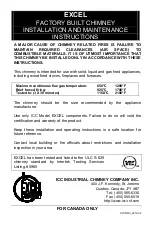
ENgLIsH
VENTILATION AND AERATION OF THE INsTALLATION PREMIsEs
As the product draw their combustion air from the place of installation, it is
MANDATORY
that in the place itself, a sufficient quantity of air is
introduced. If windows and doors are airtight (e.g. built according to energy saving criteria), it is possible that the fresh air intake is no longer
guaranteed and this jeopardises the draught of the appliance and your health and safety.
IMPORTANT:
For a better comfort and corresponding oxygenation of environment, the combustion air can be directly withdrawn at the
outside through a junction which is to be connected with a flexible pipe. The connection pipe (not furnished) must be flat with a minimum
diameter of
Picture 11
, a maximum length of 4 m and with no more than 3 bends. If there is a direct connection with the outside it must be
endowed with a special windbreak.
There
MANDATORY
be sufficient quantity of air for combustion and re-oxygenation of the room to ensure the device will work properly.
There should therefore be vents letting air in from outside the building and enabling circulation of air for combustion even when the doors
and windows are closed.
The air inlets must meet the following requirements:
• they must be protected with grids, metal mesh, etc., but without reducing the net useful section;
• they must be made so as to make the maintenance operations possible;
• positioned so that they cannot be obstructed;
• Any extractor hoods in the room where the device is installed must not operate at the same time as this could cause smoke to enter the
room, even with the fireplace’s door closed.
The clean and non-contaminated air flow can also be obtained from a room adjacent to that of installation (indirect aeration and ventilation),
as long as the flow takes place freely through permanent openings communicating with the outside.
The adjacent room cannot be used as a garage, or to store combustible material or for any other activity with a fire hazard, bathroom, bedroom
or common room of the building.
Ventilation is deemed sufficient when the room is equipped with air inlets according to the table:
Appliance categories
Reference standard
Percentage of the
net opening section with respect to
the appliance fumes outlet section
Minimum net opening value of
the ventilation duct
Fireplaces
UNI EN 13229
50%
200 cm²
Stoves
UNI EN 13240
50%
100 cm²
Cookers
UNI EN 12815
50%
100 cm²
Installation in premises with fire hazards is forbidden. Installation in residential premises in which, in any case, the depression
measured during installation between the internal and external environment is greater than 4 Pa - reference for Italy according to
standard UNI10683.
All national, regional, provincial and municipal laws and standards in force in the country where the appliance is installed must be complied
with.
VENTILATION HOOD OR ADJACENT LOCAL
The product can distribute heated air by natural convection or forced convection by means of a centrifugal fan (see
separate instructions
OPTIONAL kit ventilation); therefore, during installation, it is necessary to establish the type of ventilation or convection to be adopted:
A) NATURAL CONVECTION:
To ease the natural circulation of air (upward movement due to the heating of the same) in the external enclosure of the stack, it is necessary
to remove the underlying semi-blanks (see
Picture 11
).
By choosing this convection system, it is recommended not to install the electrical fan.
B ) FORCED CONVECTION:
By installing a centrifugal fan, it is possible to distribute hot air to adjacent rooms by means of ducts with a length up to 4 meters. In this case,
do not remove the underlying semi-blanks (see
Picture 11
).
The covering of each product is equipped with 4 outputs with a diameter of 150 mm for the connection of pipes resistant to heat.
a) Perform the drilling on the walls or on the existing hood to allow the passage and the application of the (fire-resistant) hoses with a 15
cm diameter equipped with related openings.
b) Fasten the pipes by means of clamps to the related collars and openings, after having removed the semi-blanks caps.
c) Each pipe must not exceed 2 m of length for natural ventilation and 4 m for forced ventilation, and has to be insulated with insulating
materials to avoid noise and dispersion of heat.
d) The openings have to be positioned at a height not lower than 2 m from the floor to avoid that hot air at output meets people.
Please
respect the distance of the convection openings according to the local construction norms;
e) The lengths of the canalization pipes must have the same length to avoid the distribution of differing quantities of air from each
output (see
Picture 12
).
27
Содержание FOCOLARE 100 BIFACCIALE
Страница 2: ...ITALIANO 8 ENGLISH 21 DEUTSCH 34 FRANCAIS 47 ESPAÑOL 60 2 ...
Страница 4: ...4 x 4 x 2 3 12 x 16 x 4 x 4 x 4 ...
Страница 5: ...4 5 4 x 4 x 8 x 8 x 5 ...
Страница 6: ...6 7 8 30 x 6 ...
Страница 81: ...FOCOLARE 100 BIFACCIALE DIMENSIONES DIMENSIONS MAßE DIMENSIONS SHEETS DIMENSIONI 81 ...
Страница 82: ......
Страница 83: ......
















































